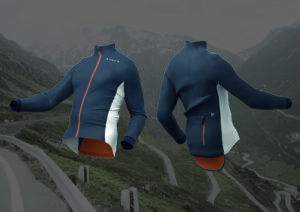Circular fashion has become a “Buzzword” with brands and suppliers talking “Circular” rather than yesterdays buzzword “Sustainable”.
Circular fashion isn’t new. It’s being banded around a lot due to the increased awareness of the damage fast fashion and careless product design has affected our planet, however circular has been around since day dot. Nature is the biggest example of circular as everything is reused and repurposed without leaving any waste or pollution.
How does this relate to sportswear and how can you become circular when you are thinking about new sportswear ranges?

Principles to create a Circular Sportswear Collection
There are 4 basic principles to create a circular sportswear collection.
1. Design out waste and pollution.
At the start of the process, the design needs to accommodate sustainability, durability, recyclability and biodegradability.
The product should be made from fabrics, components and trims that are 100% sustainable, last a long time, can be repaired or replaced if they fail or wear out and at the end of the life of the product, biodegrade to leave no toxic waste.
This process needs to consider dyes, threads, accessories and trims that are all environmentally friendly, durable and won’t pollute the earth when eventually thrown away.
2. Durability and Repair
This principle is to make sure that the product lasts as long as possible. The durability needs to be built into the design of the product, selecting fabrics, trims and components based on their quality and durability.
Eventually, something will break or wear out over time and the next stage is how we repair this failure. How the product can be mended to make it as good as new. By repairing a garment rather than replacing it, we reduce waste, power and pollution.
3. Reuse
If a repair isn’t possible, then the next principle is to explore what the components and fabrics could be repurposed for. Could the zips be removed and reused to produce more garments? Perhaps the trims could be removed and used again or the fabrics could be cut up to make new small accessories? If this isn’t an option, then the next stage would be to see if any of these ingredients could be recycled into new components or fabrics.
4. End of Life
Producing a garment made from natural and biodegradable fibres and materials will cause no pollution or damage when the garment is thrown away.
Merino wool for instance will degrade naturally within the month and put back the nutrients into the soil taken to grow the wool in the first place. This is a perfect example of using nature to grow fibre (water and grass) and then putting back nothing harmful when it degrades naturally.
The opposite of this would be Polyester or Nylon. These are made from synthetic petrochemicals that take decades to degrade and pollute the earth when they are thrown away. They also pollute our water system every time they are washed as millions of synthetic fibres are washed into the ocean that has a huge effect on our marine life.
It doesn’t end there though as there are other steps that can be taken to help become more circular and look after the planet.
1. Produce Less
The fashion industry has been driven by growth and targets with the majority of brands producing far more than they actually sell.
According to the Ellen MacArthur Foundation, over 100 Billion garments are produced annually and from 2000 to 2014, clothing production actually doubled with the average lifespan of garments being halved. This is clear evidence that quality and durability has been replaced with fast, throw away fashion that is killing the planet.
Many brands need to clear surplus stock they purchased at reduced prices, hurting their margin and brand position and sometimes brands destroy surplus stock in an attempt to manage their brand position.
This is going to take some time to conquer, but if brands start to focus on durability and quality rather than target price and use this as their USP, then consumers wouldn’t need to buy as much. This would reduce the need to produce as much clothing that reduced raw materials, power, and pollution.
The main issue will be to convince and educate consumers to buy better and make garments last rather than be focussed on the latest trend or cheap prices.
2. Design out the waste
As you design your products, you should start to think about what is essential and what is surplus. If we remove the surplus and focus on the essential, we will end up with a much simpler product that will cost less to produce and has less chance of breaking.
The design should also consider how it will be used, potential wear areas and how to make these areas more durable or repairable when they do break.
By thinking this way when designing garments, you start to protect the planet over several years or even decades as the garment will no doubt have a much longer life spa.
3. Reuse and Repair
The most sustainable garment is the one you already have in your wardrobe. If we all got creative and repurposed our old clothes by updating them with accessories or trims to make them look and feel like new styles, then this would eliminate the need to purchase new garments.
The 2nd most sustainable garment is to purchase second-hand garments, again giving them a 2nd life and reducing the need to purchase brand new.
Alternatively, we could look to borrow or rent garments than purchase new ones. This works especially well when you need a garment for a special occasion and potentially only wear it once. Proms, weddings, interviews may all require a special garment you don’t already own but hiring or borrowing would reduce waste.
Any styles that eventually break or wear out should be repaired if possible and there are more and more options available to facilitate this repair. We offer our customers the opportunity to repair their customer’s garments where the garments are sent back to the factory for a professional repair, be it a broken zip, seam or even ripped panels that can be patched or replaced.
This repair strategy should be considered at the design stage and if a brand is looking to offer repairs, then it might be worth holding onto the scrap leftover fabrics and trims from every production run so you can match 100% the ingredients to make the garments look as good as new.
Most factories need to over-order fabric, trims and components to safeguard them against waste or faults and these fabrics and trims could be stored for future repairs.
If you are looking to create a circular range of sportswear and would like to discuss the options available, then please get in touch. We can manage the design process and build in sustainability, biodegradability and durability and then future proof the circularity by offering a repair service to the garments in years to come through the same factory that made the original garment.




